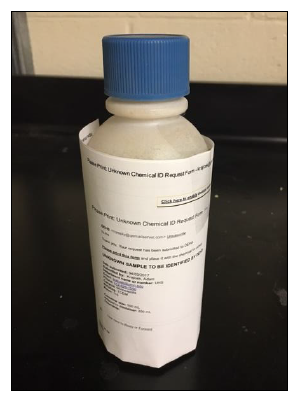Unknown chemicals are a serious problem in laboratories. Every effort should be made by laboratory personnel to identify unknown chemicals. Ask other laboratory personnel if they are responsible for, or can help identify the unknown chemical. The Principal Investigator of the lab is often a good resource. If it is not possible to identify the material, an Unknown Chemical Identification Request Form should be completed and submitted to HSRM. Print the form and place it on or near the unknown chemical so it is properly labeled as illustrated in Figure 8.9. Once a request has been submitted, HSRM staff will come to the area to pick up the unknown.
Preventing Unknown Chemicals
Here are a few tips that will help prevent the generation of unknown chemicals:
- Label all chemical containers including beakers, flasks, vials, and test tubes. For more details regarding labeling, see the Non-Manufacturer Container Labeling Requirements Fact Sheet.
- Immediately replace labels that have fallen off or that are deteriorated.
- Label containers using chemical names. Do not use abbreviations, chemical structure, or formulae.
- Archived research samples are often stored in boxes containing dozens of small vials. Label the outside of the box with the chemical constituents paying special attention to regulated materials such as radioactives, organic solvents, heavy metals and other toxics. If the samples are nonhazardous, label them as such.
- Submit frequent Hazardous Materials Pickup Request Forms to reduce the amount of chemicals in your laboratory.
Employees should dispose of all of their waste before leaving/graduating from the UMN. The department should come up with a system to ensure that all faculty, staff, and students properly dispose of chemical waste, including unwanted research samples, before employees leave.
